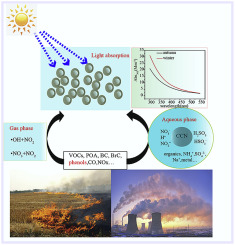当前位置:
X-MOL 学术
›
Atmos. Environ.
›
论文详情
Our official English website, www.x-mol.net, welcomes your feedback! (Note: you will need to create a separate account there.)
Light absorption properties of brown carbon (BrC) in autumn and winter in Beijing: Composition, formation and contribution of nitrated aromatic compounds
Atmospheric Environment ( IF 5 ) Pub Date : 2020-02-01 , DOI: 10.1016/j.atmosenv.2020.117289 Xingru Li , Yang Yang , Shuiqiao Liu , Qing Zhao , Gehui Wang , Yuesi Wang
Atmospheric Environment ( IF 5 ) Pub Date : 2020-02-01 , DOI: 10.1016/j.atmosenv.2020.117289 Xingru Li , Yang Yang , Shuiqiao Liu , Qing Zhao , Gehui Wang , Yuesi Wang

|
Abstract Nitro-aromatic compounds (NACs) are an important part of brown carbon because of their strong light absorbing properties in the visible and near ultraviolet regions. In this study, the concentration and formation mechanism of eight NACs, as well as their relative contribution to the light absorption of methanol-extracted BrC, were determined from fine particle samples collected in Beijing using ultra-high performance liquid chromatography coupled with high resolution mass spectrometry and ultraviolet–visible light spectrophotometry. The average concentrations of the eight NACs were 20.27 ± 12.40 ng m−3 and 74.17 ± 50.66 ng m−3 in autumn and winter, respectively. Among the detected NACs, 4-nitrophenol (4NP) and 4-nitrocatechol (4NC) were the most abundant compounds. The correlation analysis showed that the NACs other than 2,4-dinitrophenol (2,4-DNP) are strongly intercorrelated. Significant correlations among nitro catechols (NCs), nitro salicylic acids (NSAs) and NO2 support their proposed origin from secondary formation in the presence of •OH + NO2 (daytime process) or •NO3+NO2 (nighttime process). Significant correlations among nitrate, sulfate and NSAs were also found, indicating that the nitration of salicylic acid by nitric acid and sulfuric acid was another possible mechanism formation of NSAs. The methanol-extracts in winter had much higher light absorption than those in autumn, which is in agreement with the trend of NACs but contrary to the trends of PM2.5, water soluble ions, organic carbon and elemental carbon. The average absorption Angstrom exponents (AAEs) during autumn and winter were 4.62 and 5.55, respectively, suggesting that secondary transformation were the main sources of BrC. The light absorption of NACs accounted for 1.17% and 3.18% of the total methanol-soluble BrC light absorption at λ = 365 nm in autumn and winter, respectively, while their masses only accounted for 0.16% and 0.44% of the OC, respectively, demonstrating that although NACs are not the major contributor to BrC, but they are strong BrC chromophores, and their influence on solar radiation should be included in future modeling work.
更新日期:2020-02-01

























 京公网安备 11010802027423号
京公网安备 11010802027423号